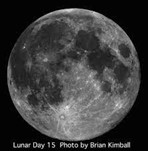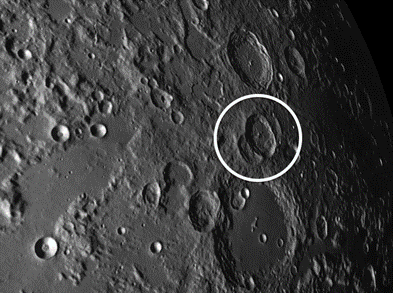The week of January 17-23 takes us from Full Moon to Day 21. This week we will highlight the moon craters Geminus and Burckhardt, viewable on Tuesday and Wednesday nights.
 Geminus: [NE/F15] Roughly 200 miles north of Mare Crisium 1 you will find the moderately complex 55-mile crater Geminus. It has terraced walls and small central peaks. This will give you an indication of what to start looking for as craters become increasingly more complex.
Geminus: [NE/F15] Roughly 200 miles north of Mare Crisium 1 you will find the moderately complex 55-mile crater Geminus. It has terraced walls and small central peaks. This will give you an indication of what to start looking for as craters become increasingly more complex.
 Burckhardt: [NE/F15; L=57°E] This is the moon crater with the “Mickey Mouse ears.” It is a remarkable exception to the rule that when one crater intrudes upon another, the younger crater (the intruder) is smaller. Burckhardt has landed smack in between two smaller but older craters, giving it the Mickey Mouse effect.
Burckhardt: [NE/F15; L=57°E] This is the moon crater with the “Mickey Mouse ears.” It is a remarkable exception to the rule that when one crater intrudes upon another, the younger crater (the intruder) is smaller. Burckhardt has landed smack in between two smaller but older craters, giving it the Mickey Mouse effect.
1 200 miles would be about three arc-minutes north of Crisium. Being familiar with the field of view (FOV) of your eyepieces will help you navigate.
======================
It is highly recommended that you get a copy of Sky and Telescope’s Field Map of the Moon, the very finest Moon map available for use at the telescope. It is available for $10.95 at www.skyandtelescope.com and on Amazon. All features mentioned in this blog will be keyed to the grid on the Field Map and will look like this: Plato: [NW/D9]
Credits:
Courtesy of Gray Photography of Corpus Christi, Texas
Lunar photos: NASA / USGS / BMDO / LROC / ASU / DLR / LOLA / Moon Globe. Used by permission
- Rupes Cauchy: A Best Known Fault on the Moon - July 22, 2024
- Moon Crater Schickard – Crater Floor has Stripes - July 15, 2024
- Moon Craters Langrenus and Vandelinus - July 8, 2024